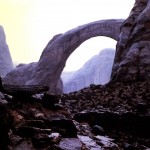
Edna Fridley was a good friend of the canyon country of southeast Utah for more than 30 years. Every year she returned to the slickrock from her home, back east, to wander and explore what was then one of the…
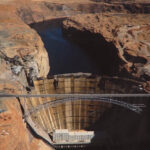
If you didn’t live through the 1950s, there’s a commonly held but false impression that ‘nothing happened’ during the decade… But the decade of the ‘50s initiated the groundwork, literally, for what was to come. After a decade of the Great Depression and four years of world war. Growth was inevitable, but the explosive growth was stunning…
In order for the arid Southwest to grow far beyond anything that could be called “sustainable,” proponents needed two rare commodities for the arid deserts — water and power. Projects like Glen Canyon Dam and the Powell Reservoir were planned and built with that goal in mind.
Damn sustainability…full speed AHEAD.
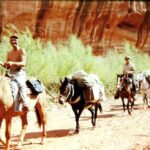
FROM KEN SLEIGHT,
“Edna soon came to Escalante and met many of the town folk. Coming and going from trips, we spent a lot of time at cousin Mohr Christensen’s Moqui Motel. My clients met there and at the other rustic-looking motels in Escalante when coming on trips.
“Edna loved Escalante Canyon and became intimately familiar with its features. We frequented Coyote Gulch more than any other canyon. It contains Jacob Hamblin and Coyote natural bridges and Jug Handle Arch. At its mouth and across the river, Stevens Arch looms high on the skyline. Negotiating this country often came hard. Going down Coyote Gulch on one trip, a giant part of the wall broke away and crashed into the creek bottom below, forming a natural dam. My old intrepid friend Vaughn Short, who helped me a lot through those years, aided me in fashioning a detour around the slide and I got our horses and mules around the long pool of water. Edna followed that trail on numerous occasions, as it led to Indian wall writings.”
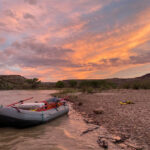
The river, when functioning accordingly, is a great democracy. “River Democracy.” All are equal. All are welcome. All are held accountable to one another for sustenance. If you can’t contribute, or perhaps more specifically, will not contribute, you will not be invited back. But if you can, as I have learned, you will be welcomed into one of the greatest gifts known to humankind; the River Family.
Family has never been easy for me. I have a hard time telling my mother “I love you” (even though I clearly do), and I tend to stay immersed in the day-to-day happenings of my own life that I forget to call and check in regularly. I have never been a great sibling to my younger brothers and sister. While I love them to death, our upbringing was, at times, chaotic and unstructured.
But on the river, family is a necessity. One of the greatest joys of the river is accountability to one another. To rely on one another. To help one another. To know that we are all in this together, for better or worse. Aside from running a class III or IV, this is one of the most enjoyable yet fundamental elements of river running with a group. Adhesion and effort. But on this trip, “family” had a new dynamic because, after almost a lifetime of existence, I had just met my biological father weeks before. And though he wasn’t with me physically on this river journey, his presence was very much felt.
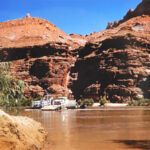
CHARLES KREISCHER & EDNA FRIDLEY loved the West, and especially the Colorado Plateau. Both explored the canyons of southeast Utah in the days when very few people even knew they existed. At the time, most Americans’ knowledge of the Colorado Plateau came from John Ford movies, and they rarely mentioned film locations in the credits. But Charlie and Edna knew, and they took hundreds of amazing Kodachrome transparencies to remember their experience
In a previous issue The Zephyr published images by Kreischer and Fridley of the road to Hite Ferry— old Utah Highway 95 — which remained a dirt and gravel road from Blanding to Hanksville, until the rising waters of Lake Powell flooded the ferry. Subsequently, three bridges were built, at a cost of millions of dollars, to connect the east side of the reservoir to the west.
In this issue we focus entirely on the Hite Ferry itself and the surrounding area. And at the end of this post, look for some new information and of new images yet to come…JS
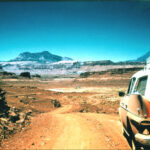
In this selection of Kodachrome transparencies by Edna Fridley and Charlie Kreischer, I assembled the images as if one were traveling from Hanksville to the Hite Ferry, and then eastward through White Canyon, and past the Bears Ears on the way to Blanding. The entire journey was about 135 miles. These photos were taken by both photographers and at different times, between 1959 and 1962. I’ve done my best to assemble them in order, based solely on my recollection of the landscape after driving Utah 95 hundreds of times over the past 51 years…JS